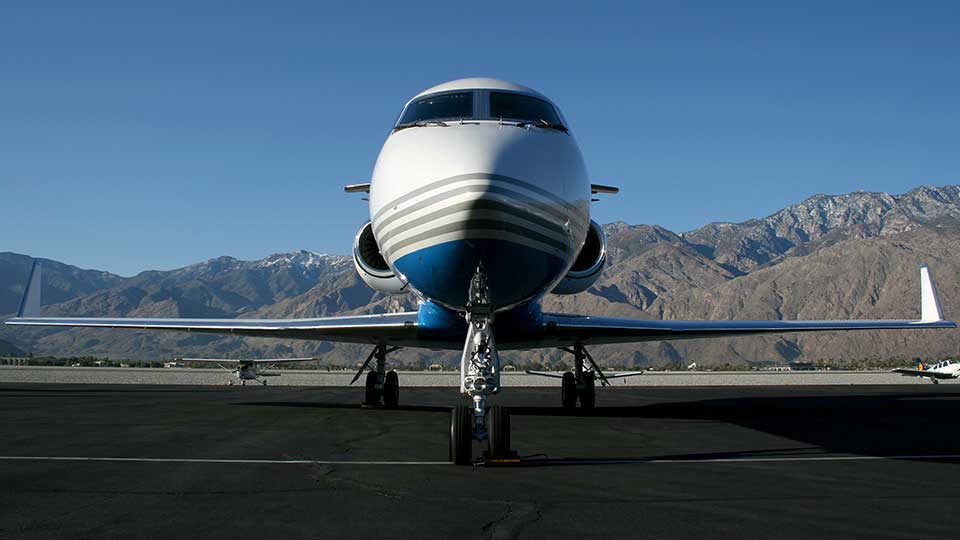History of Gulfstream
Part I

Founding and First Aircraft
At the end of WW2, Roy Grumman, (co-founder of Grumman Aircraft Engineering Corporation), proposed the development of a new business aircraft for executive transportation. After thirteen years of research and engineering Grumman introduced the Gulfstream I. The Calverton Airport Grumman Facility, located on the east end of New York’s Long Island, launched the first flight of the G1 on August 14, 1958. This new aircraft paved the way for executives to conduct private company meetings while traveling to and from their destination cities for new business after the aircraft entered service in 1959.
The aircraft featured Rolls Royce Dart turboprop engines mounted atop low wings. The GI can fly as fast as Mach 0.53 at 33,600 feet (10,241 meters) with a range of 2,540 nautical miles (4,704 kilometers). The cabin can carry up to 12 passengers in a business aircraft configuration. Grumman produced more than 200 Gulfstream I aircraft over a period of 11 years. There are many Gulfstream 1’s operating today however most of them are based in South America and Mexico.
- G1 General characteristics [1]
- Crew: two
- Capacity: 10–24 passengers
- Length: 63 ft 9 in (19.43 m)
- Wingspan: 78 ft 6 in (23.93 m)
- Height: 22 ft 9 in (6.93 m)
- Wing area: 610.3 sq ft (56.70 m2)
- Empty weight: 21,900 lb (9,934 kg)
- Max takeoff weight: 35,100 lb (15,921 kg)
- Powerplant: 2 × Rolls-Royce Dart 529 turboprop, 2,190 shp (1,630 kW) each
- Performance
- Cruise speed: 348 mph (302 kn; 560 km/h) (max cruise, at 25,000 ft (7,600 m)
- Range: 2,540 mi (2,207 nmi; 4,088 km)
- Service ceiling: 33,600 ft (10,241 m)
- Rate of climb: 1,900 ft/min (9.7 m/s
[1] ** Jane's All The World's Aircraft 1965-66
Finding Success
In 1960 during full production of the Gulfstream 1, movers behind the aircraft were already moving towards a new goal, the Gulfstream 2. This new aircraft would become a business jet capable of crossing the Atlantic Ocean, allowing businessmen to expand their business operations overseas.
SIX YEARS LATER ON OCTOBER 2, 1966 the Gulfstream II made its first flight and on May 4, 1968 and it became the first business jet to fly from the US to Europe across the Atlantic Ocean nonstop.
The Rolls Royce Spey jet engines were mounted on the rear of the fuselage and the tail was modified in a T configuration to accommodate the location of the new engines. The wings were swept back to increase range and altitude. The aircraft is capable of flying up to Mach 0.88 at 45,000 feet (3,761 meters) with a range of 3,680 nautical miles (6,815 kilometers). The cabin can accommodate up to 19 passengers with a typical 12-15 passenger configuration. More than 250 GIIs sold during the aircraft’s production run including three variations. The first one with wing-tip tanks to increase range, the second, Gulfstream installed the new redesigned, G3 wing. This increased fuel capacity gave the G2 more range and better performance. The third G2 variation was developed by Aviation Partners (a aerospace engineering company developing products to maximize performance for different aircraft) added blended winglets to the wing for enhanced performance, range and fuel efficiency for a reasonable price. Gulfstream went on to produce 258 G2’s.
In 1973, NASA and Grumman designed and modified the Gulfstream 2 to mimic the flight characteristics of the Space Shuttle giving astronauts a realistic training environment for the up coming Space Shuttle program.
- G2 General characteristics [1]
- Crew: two
- Capacity: 19 Maximum
- Length: 79 ft 11 in (24.36 m)
- Wingspan: 68 ft 10 in (20.98 m)
- Height: 24 ft 6 in (7.47 m)
- Wing area: 809.6 ft2 (75.21 m2)
- Empty weight: 36,544 lb (16.576 kg)
- Max takeoff weight: 65,500 lb (29,711 kg)
- Powerplant:2 × Rolls-Royce Spey 511-8 turbofan, 11,400 lbf (51 kN) each
- Performance
- Cruise speed: 483 mph (778 km/h)
- Range: 4,123 miles (6,635 km)
- Service ceiling: 45,000 ft (13,715 m)
- Max Speed: .85 Mach
[1] ** Jane's All The World's Aircraft 1965-66
Conclusion Part 1
Within 6 Years of producing the Gulfstream 1, the company has exploded into one of the most popular and capable jets in the business class. As the company approaches the '70s they have a lot to look forward to. The next installment in this series will cover the second half of the 1900's and the placement of Gulfstream as one of the leaders of the industry.
Gulfstream History 2



















